Check out Dead Ringer Snake Eyes Sights at https://deadringerhunting.com/
If you grew up watching or playing sports, you’ve probably heard the term “high ceiling” applied to a rookie or freshman player. Athletes with a high ceiling have the potential to be great—they’re freakishly athletic or they have a strong work ethic—but they’ll need good coaching and lots of practice to reach that potential.
“High ceiling” kept running through my mind the first time I took Dead Ringer’s Snake Eyes pistol sights to the range. With the right instruction and practice, these bad boys could be a great addition to any concealed carry or home defense handgun. You might find yourself frustrated at first as you learn to use a new sighting system that, admittedly, has its drawbacks. But, given enough practice, these sights allow for lightning-quick target acquisition and the flexibility to land shots in a variety of scenarios.
Installation
Dead Ringer recommends (clearly and in multiple places) that these sights be installed by a professional gunsmith. The company includes an installation warning on their website, and the box says to “consult a professional gunsmith” before installation.
If you’re uncomfortable with this kind of work, by all means call your local gunsmith. But I figured that most of you—like me—would prefer not to spend the extra money. So I decided to try the installation myself and record the process. It turned out to be a piece of cake.
I removed my old sights with a hammer and a brass punch. I used a few drops of gun oil to help the process, and I had the front and rear sights off in no time. I would have liked to secure the slide in a bench vice, but I was able to make do by pressing the slide against the table with the heel of my hand.
[one_half]
[/one_half]
[one_half_last]
[/one_half_last]
I installed the new sights the same way I removed the old. I tried to protect the finish by placing a cleaning patch between the brass punch and the sight, which slowed down the process but kept the sights looking good.
[one_half]
[/one_half]
[one_half_last]
[/one_half_last]
I stopped once I got each sight roughly centered on the slide. I wasn’t too worried about exact precision, as I knew I’d have to adjust the sights when I got to the range anyway.
[one_half]
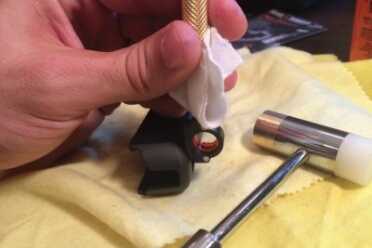
The rear sight was a tight fit, but I eventually got it where it needed to be. Don’t be shy with that hammer, though. It takes a few firm strokes to move the sight within the slide notch.
[/one_half]
[one_half_last]
[/one_half_last]
That’s about it. It’s always good to follow the manufacturer’s recommendations (especially with firearms), but I don’t think it’s necessary to take these sights to a gunsmith.
Function and Durability
The rear sight is smaller than I had imagined, which reduces the size of the sight picture but also keeps the sight from being too obtrusive. I hadn’t thought it would be possible to use these sights on a concealed carry gun, but I’ve reconsidered that position. Depending on your style of carry, the Snake Eyes could easily be used on a concealed firearm.
The dots are tritium, which glow green in the dark. The orange ring is made of “optical Lexan light pipes,” which, according to Dead Ringer, glow during daylight and low light conditions but do not glow in total darkness. This is exactly what I discovered in my testing. The tritium dots glow brightly at low light and in darkness, and the orange ring only needs the aid of a flashlight to become visible. And since I can’t imagine a time when I’ll be firing without at least the aid of a flashlight, I think that’s more than adequate.
[one_half]
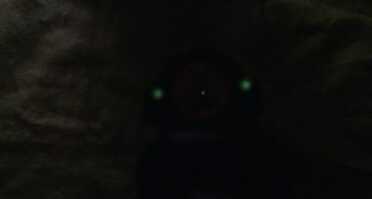
This is how the sights would appear in total darkness. You can see the orange ring disappears, but the tritium dots glow brightly.
[/one_half]
[one_half_last]
[/one_half_last]
I’ve heard that this sighting system has a reputation for fragility. I showed the Snake Eyes to a long-time gunsmith at the range, and he immediately mentioned how the rear circle has a habit of breaking. That may be the case with products from other companies, but these sights by Dead Ringer are as solid as a rock. Both the front and rear are constructed from military-grade metal. I haven’t been using the sights for long, but I can’t imagine how I’d break them. The relatively low profile of the rear sight also minimizes the chances of accidental snags or bumps. If you’re considering these sights for your next upgrade, I wouldn’t worry about dependability.
At the Range
There’s only so much you can learn dry firing at your office wall, so I was excited to test the Snake Eyes with some live ammunition. My first job at the range was to acclimate myself to the sights without worrying too much about accuracy. Each set of pistol sights is different, and I wanted to determine if these had any quirks.
You can see from my first set of targets that the sights consistently pulled my shots to the left. Making horizontal corrections is a simple process, so I wasn’t too concerned about this. (Pro Tip: To correct left-to-right alignment, the front sight follows the bullet and the rear sight moves in the opposite direction. In other words, if your shots are landing to the left, move the front sight to the left or the rear sight to the right).
More troubling was the tendency for the sights to pull my shots high, which you can see from the middle and bottom-left targets. I tried to center my shots by moving the front sight down within the orange circle, but there isn’t a way to adjust these sights for vertical inaccuracy.
[one_half]
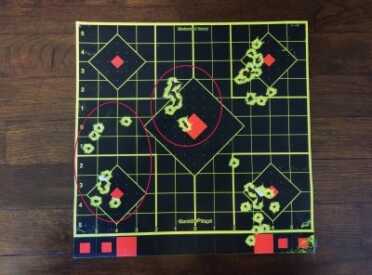
When I placed the front sight directly in the middle of the rear circle, my shots tended to hit high. (Distance: Seven yards).
[/one_half]
[one_half_last]
[/one_half_last]
It was at this point I started to learn both the advantage and the disadvantage of these sights. Once I determined that the sights were pulling my shots high, it was easy to adjust the location of the front sight within the rear circle. The space within the circle is large enough to tell when you’ve moved the front sight up or down. But I found it difficult to place the front sight in precisely the same location for the next shot. You can see from the top right and top left targets that when I tried to correct for shooting too high I tended to shoot too low. There’s so much space within the rear sight that I couldn’t determine exactly where to place the front sight.
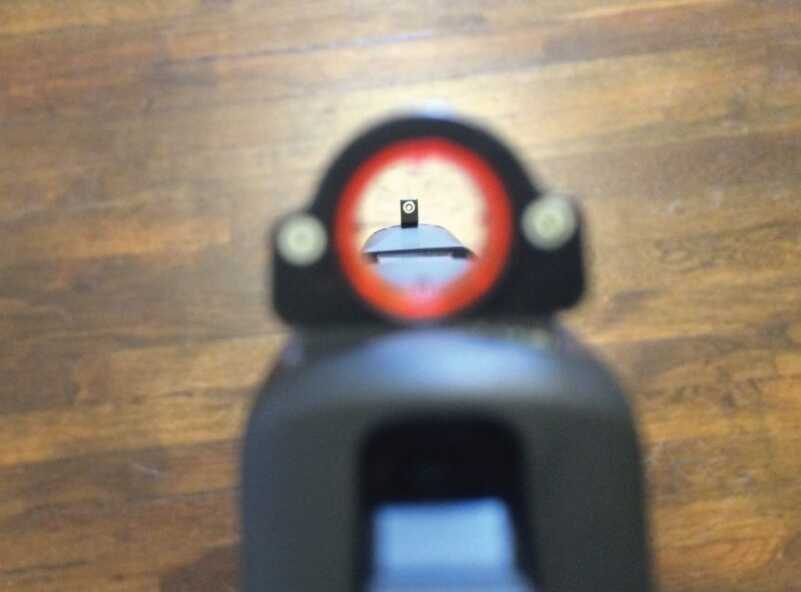
All that space within the rear circle can make it tough to place the front sight in exactly the same location for every shot.
I ran into a similar problem with my next set of targets. I corrected the pull to the left, but I was never able to get consistent vertical accuracy.
I’m not a great marksman with a pistol (or a rifle, for that matter), so don’t take my poor shooting as a point against the Snake Eyes. Sighting systems aren’t “accurate” or “inaccurate.” As long as they function correctly, the success of a pair of sights or a scope depends entirely on the shooter, firearm, and ammunition. But I do think the problem I faced—not knowing quite where to place the front sight within the rear orange circle—would trouble even the most experienced marksman.
[one_half]
[/one_half]
[one_half_last]
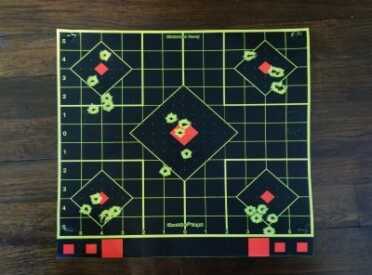
After adjusting for horizontal accuracy, I began to get more acclimated to the sights. But it was still tough to get much consistency. (Distance: Seven yards).
[/one_half_last]
Now that I’ve explained the potential weakness of these sights, let me explain their strengths, which I think more than make up for the disadvantages I’ve discussed so far.
First and foremost, the Snake Eyes allow the shooter to acquire the target quickly. As per the Dead Ringer website, these sights are designed primarily for self-defense and close quarter combat situations. I discussed the accuracy difficulties I experienced because I knew that the average shooter would likely experience the same problems the first time at the range. But, ultimately, these sights are designed for a home defense or concealed carry handgun—not for target shooting or hunting.
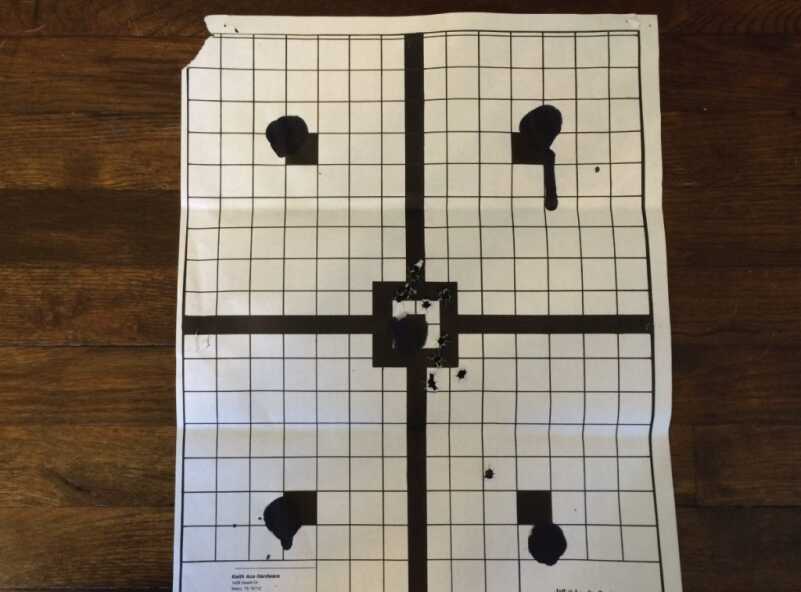
My hits are a little tough to see, but all of them except one were within a four-inch diameter in the middle of the target. (Distance: Seven yards).
All that to say, I was pleased with how quickly I was able to acquire a target using these sights. I shot at the white target from seven yards, drawing and shooting as quickly as possible. As you can see, all but one of the shots would have hit center mass. (If you don’t think that’s good shooting, you should see my groups when I do this drill with standard three-dot sights.)
Finally (and most importantly), difficult to use does not mean impossible to use. I had trouble placing the front sight in the exact same position for each shot, but I’ve only worked with the sights once. With practice, I could no doubt improve my accuracy, making these sights both functionally precise and ideal for home defense and concealed carry. That’s what I mean when I say the Snake Eyes have a high ceiling—they take practice to use effectively, but you could very well end up with the best sights you’ve ever owned.
You can purchase the Snake Eyes by Dead Ringer here for $124.99. They have models available for all the most popular handguns.
###
About the Author: Jordan Michaels is a new convert to the gun world. A Canadian immigrant to the United States, he recently became an American citizen and is happily enjoying his newly-acquired Second Amendment freedoms. He’s a communications professional, a political junkie, and an avid basketball fan.

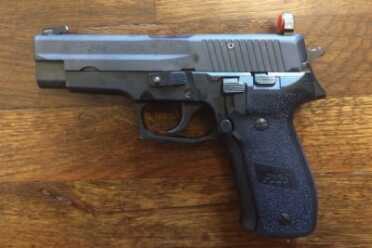
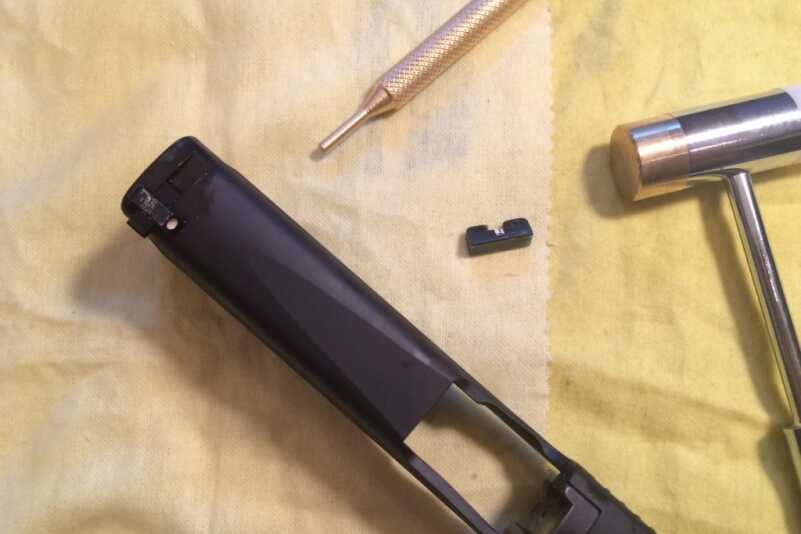
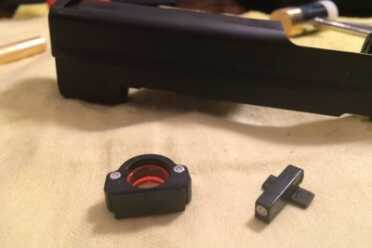
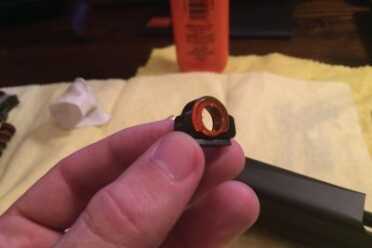
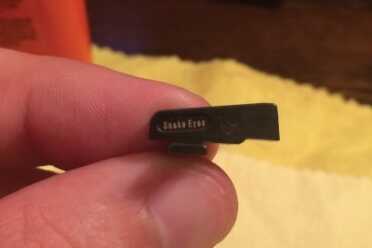
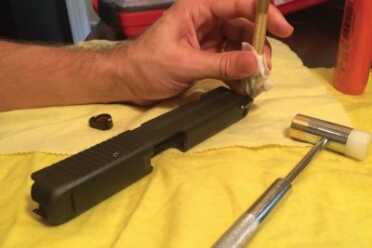
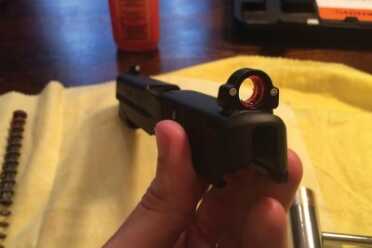
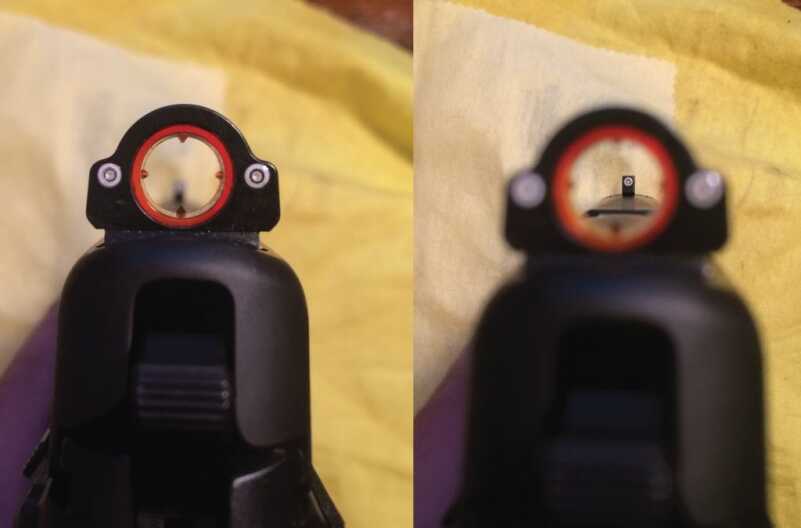
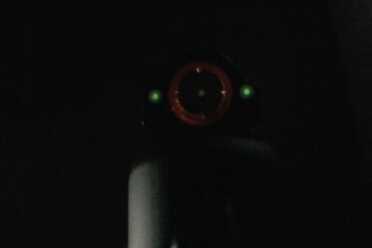
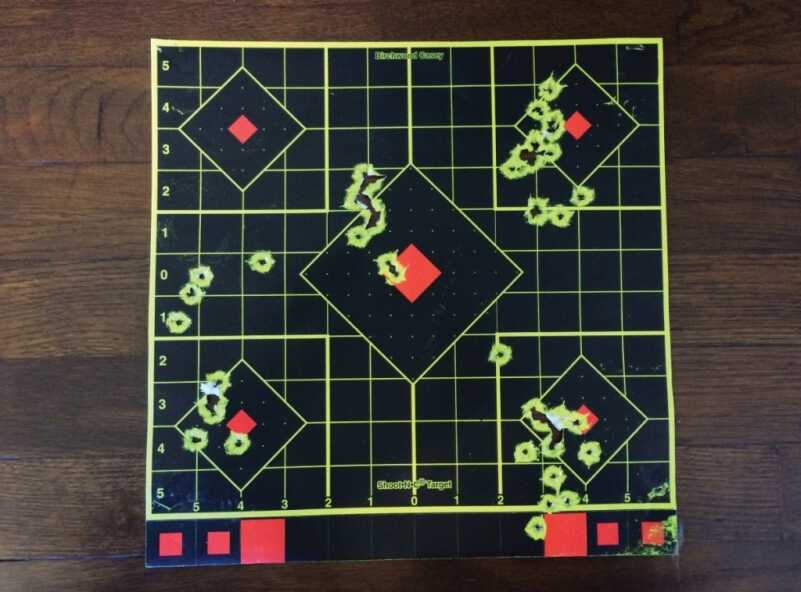
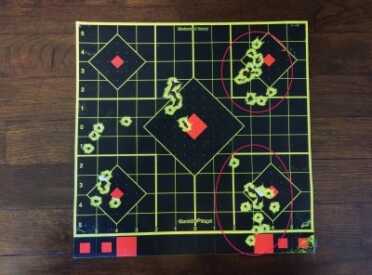
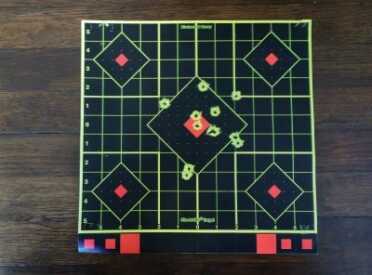
I was taught that the eye wants to center the top of the post in the rear peep auto-magically and is very repeatable. If one has to hold the post off center high or low somethings amiss. I would center the sight and hold a bit low on the target to compensate. Much more repeatable.
That’s great. I’ve wondered if something like that existed. I tried ghost-ring sights on a shotgun and it was amazing, but the rear sight disintegrated when shooting turkey loads. I have a .22 rifle with steel ghost ring sights and it’s nice, in bright light. These ought to be great for a winter hunting pistol.
For someone who said this is perplexing. Nah, it’s a reflex sight. Just another way to skin a cat.
I purchased a set for my g34 and I have to say that they are very fast at acquisitioning targets. I myself put them on and was not hard at all with the right tools. I’ve had them on for 8 months and I haven’t paper punched with them yet . I have some friends that teach cosmology and when the mannequins can not be practiced on by the students I get them for practice. Between 7-10 yrds is as far as I’ll have them and ill practice taking my time on aiming and then as fast and safely as I can. And I must admit that it took a bit getting used to but it didn’t take long to get the hang of it. The sights are sturdy and strong enough to rack the slide with , I do it all the time . Very good product , and happy and confident with them.
I am 72 and was troubled with aging eyes. Conventional sights just didn’t get it done anymore if surviving a gunfight is your goal I needed better sights. I put a set of Advantage sights on my Glock 23 and they are a natural guide to line up and are adjustable front and rear on the Glock. The front up and down with shims and the rear left and right in the dovetail. Great sights. Just bought a new EMP4 and had cataracts removed from both eyes, the last one today. I can’t wait to see how this will work out with sights and shooting. The first eye came out 20/20.
I had them installed on my G34 and really like them. I have had only one session with them, but I will try more in the next few days.
Nice article. I think I’ll stick with my XS sights.
I find this design very perplexing. If the sights are not regulated to work when in normal alignment it is a flawed design. As such, if you use the night sights your impact will be off. Also at night you dont have the red ring as a reference to “adjust” thecsught picture. It was basically said the sights aren’t for percise work but you can get use to them and get better results. Where they are suppose to top notch is close in quick work. This however relies on the standard primary front sight post method. This has been used with great success for decades without looking through a rear apature or ghost ring: post on target – shoot. Simple effective. Do you need a red ring with little points directing your eye to the post? Does this make it faster for someone who is already proficient at point shooting? I really don’t know. The way I see it there are several deficiencies and “maybe” a advantage. Heres the bad: You learn how to hit with it but who else do you depend on that can’t.